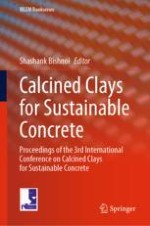2020 | OriginalPaper | Chapter
Quantifications of Cements Composed of OPC, Calcined Clay, Pozzolanes and Limestone
Authors : S. Galluccio, H. Pöllmann
Published in: Calcined Clays for Sustainable Concrete
Publisher: Springer Singapore
Activate our intelligent search to find suitable subject content or patents.
Select sections of text to find matching patents with Artificial Intelligence. powered by
Select sections of text to find additional relevant content using AI-assisted search. powered by
Abstract
-
Rietveld method of these complex systems, including determination of amorphous contents
-
Set up and application of a referenced file using Partial or not known crystal structure (PONKCS) method for further quantification
-
Cluster analysis including the various 2–4 component systems and summarizing similar phase contents and properties
-
Set up and determination of phases and contents by partial least squares refinement (PLSR) method.
